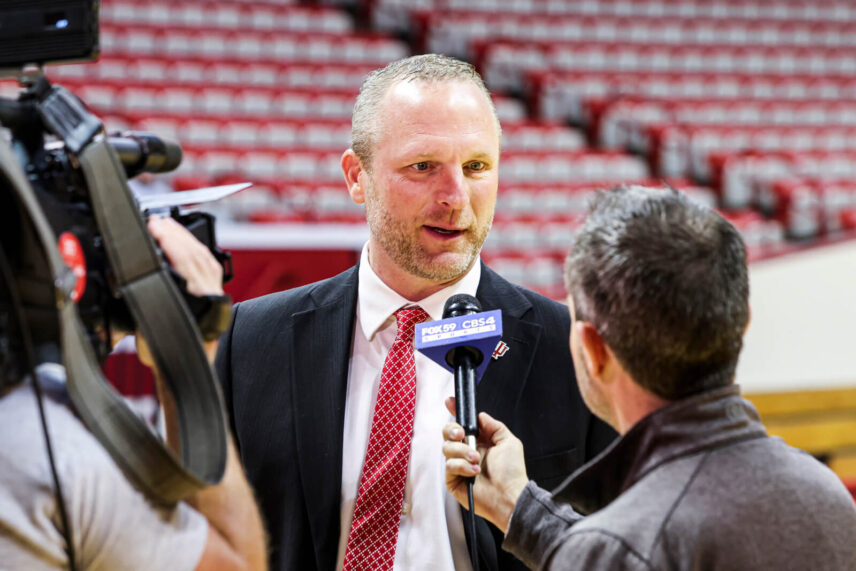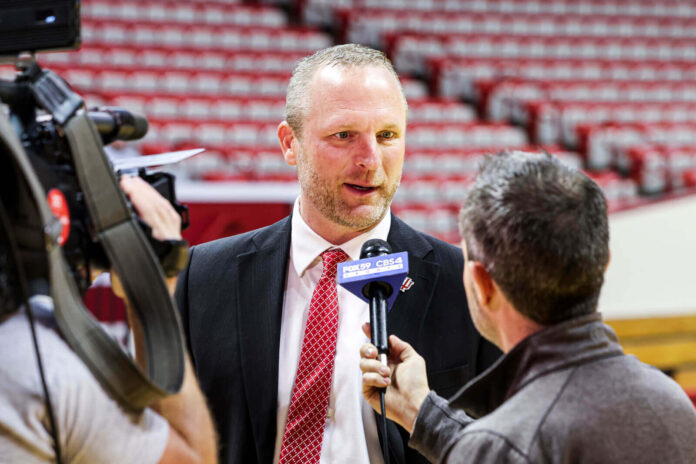
Outside of transfer news, it’s been a relatively quiet offseason in Bloomington as Darian DeVries prepares for year one with Indiana. May 28, DeVries spoke with the media for the first time since his introductory press conference at Huber’s Winery for a Hoosiers Connect NIL event.
“I think it’s been really fun to watch the staff come together, watch the team come together, and now getting closer to getting on the practice floor,” DeVries said.
Able to speak more in detail on the season’s outlook with a near-completed roster – the Hoosiers have two open scholarships – DeVries added insight about how the roster came together, the program’s recruiting approach and some hints on how the personnel will fit on the court.
As the newly constructed Hoosiers near closer to taking the practice floor for the first time, here are some takeaways from DeVries’ comments.
Perimeter shooting and positional size as strengths
The very first question DeVries addressed pertained to strengths for next year’s team. “I think we’ve got great depth in shooting the basketball, which is a priority for us,” he said. “I think for the most par,t we’ve got good positional size at a lot of the spots.”
Let’s start with the shooting. IU adds six transfers who shot 35 percent or higher from long range at least once in their career and all but one (Reed Bailey) did so on three or more attempts per game. Additionally, four incoming Hoosiers have attempted 190 or more 3-pointers at least one season – not a single Indiana player has done so since James Blackmon Jr. in the 2016-17 season. On top of the incomers, IU still has two open scholarships and hopes Luke Goode, last year’s top 3-point threat, can return as well via waiver.
That 2016-17 season was the last time IU ranked in the top half of the Big Ten in threes attempted or made, but Indiana will look to centralize its offense through shooting 3-pointers and has several talented shooters on the roster to do so. DeVries’ West Virginia team was third in average attempts and fourth in average makes last year, so his track record suggests his comments are more than offseason talk.
Next, positional size. Indiana’s guards and wings are generally taller but still have good mobility and the skillsets to play those positions. Three Hoosier guards – Tucker DeVries, Nick Dorn and Jasai Miles – are 6-foot-6 or 6-foot-7. So, what does that do?
The positional size advantages will allow DeVries and his staff to be flexible with lineup combinations. Especially with size concerns down low, Indiana can usher out several different lineups that provide different looks. For example, if the Hoosiers want to optimize shooting and play small ball, they can still put out a guard/wing at 6-foot-7 to play the four spot and space the floor.
Lack of size and alternate rim protection at the five
The center position has been Indiana’s most reliable for several years going, but that won’t be the case in year one of the DeVries era and maybe the long run. With 6-foot-11 Bailey and 6-foot-9 Sam Alexis as the tallest Hoosiers, DeVries acknowledged this at Huber’s.
“I don’t anticipate us having great rim protection,” he said. “We’re a little undersized at the five spot… rim protection isn’t always blocked shots. There’s a lot of ways to protect the rim.”
Obviously, blocking or altering shots at the rim is the most preferable way to protect the rim. However, he isn’t wrong, but he also didn’t address those alternatives besides the team’s balance and playing into strengths.
One of those is disruptive perimeter defense. Between Tayton Conerway and Conor Enright, the Hoosiers have two pesky and bullish on-ball defenders. Both will hound whoever has the ball in their hands and there’s no need to protect the rim if the ball doesn’t reach the paint.
Another can be precise rotational help. Neither Bailey nor Alexis are great paint protectors even with their height, but considering the height and length of the wings, quick rotations to the ball from help-side defenders in DeVries’ man-to-man defense can help force the ball back outside.
The coach’s history bodes well, as he’s never coached a team below No. 155 in KenPom’s adjusted defensive efficiency. Last year at West Virginia, the Mountaineers ranked No. 15 in the category.
Recruiting not just for players, but to establish an identity
DeVries has made his stance on a program’s culture clear since day one.
“You’re not building a collection of players. You have to build a team, and a team has to be able to fit together, play together, win together, be able to function together,” DeVries said at his opening presser on March 19. “It’s critical that you make sure that every player’s motivation is the right motivation for why they want to be a part of your program.”
With his first roster in Bloomington nearing completion, he shared similar sentiments on his recruiting approach. Not just for this year’s team, but for the future of the program.
“The biggest challenge is we want to make sure that everybody we’re bringing in is what we want not only for this year, but for long term in terms of establishing who we want to be, what we want that to look like, making sure that they can complement each other on the floor, off the floor,” DeVries said.
On a simple level, DeVries attacked the portal this offseason and brings in a high level of experience but the potential for continuity for the program. At least four transfers have two or three years of eligibility remaining, plus Trent Sisley arriving as a freshman.
On a deeper level, while DeVries accessed a war chest to assemble this roster, it wasn’t for a one-and-done winning season. He highlighted his emphasis on recruiting players with high character, guys who will fit well and play for the team, not themselves. DeVries wants to maintain this recruiting approach year after year and establish an identity for Indiana.
Category: Media
Filed to: Darian DeVries





















